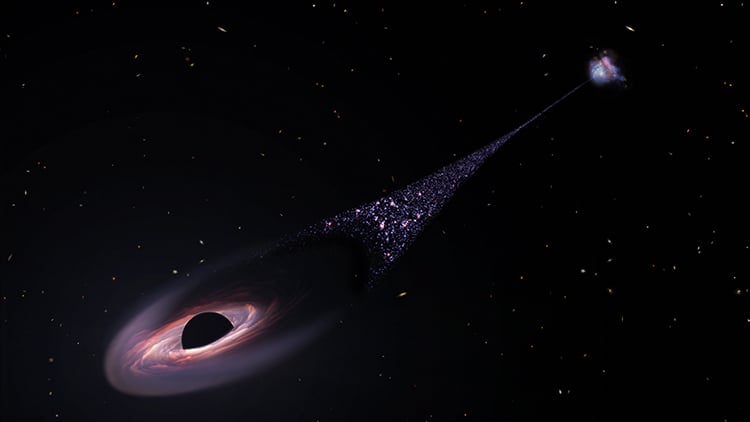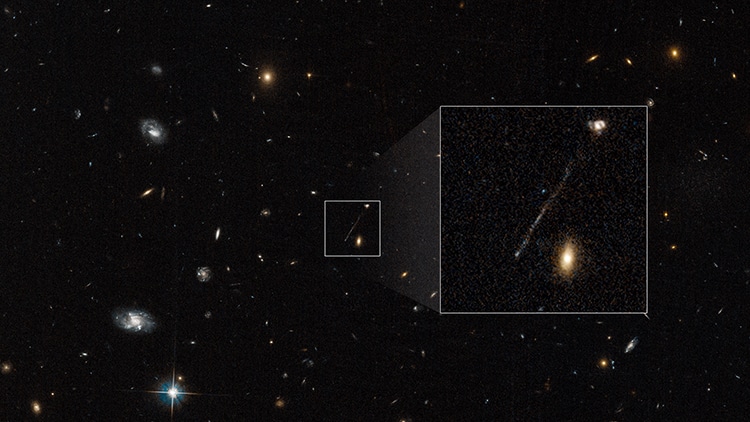
An artist’s rendition of the supermassive black hole on the run through the universe. (Photo: NASA, ESA, Leah Hustak (STScI))
Black holes are famous for their gravitational power. The celestial phenomenon draws in matter with a powerful gravitational force through a process called accretion. This powerful force can even destroy stars by ripping them apart. NASA has recently discovered a surprising twist on this classic narrative. A supermassive black hole, ejected from its own galaxy, has been streaking across the universe, actually forming stars in its wake.
Yale University professor Pieter van Dokkum spotted a streak of light in a Hubble Telescope archival image. What he first thought was a cosmic ray turned out, through further research, to be a trail of newly formed, young stars. They form a trail across 200,000 light-years. Van Dokkum announced his findings in The Astrophysical Journal Letters, attributing the trail’s creation to a runaway supermassive black hole. The trail leads from a “compact star-forming galaxy” to “a bright … knot.” According to the paper, “a mixture of star formation and fast shocks” makes up the trail. The researchers postulate the supermassive blackhole may have “escaped” from the center of the galaxy and is now, quite literally, on the run.
The black hole is moving at a whopping 4 million mph across space. This unusual speed may contribute to the black hole forming stars rather than destroying everything it encounters. “We think we’re seeing a wake behind the black hole where the gas cools and is able to form stars. So, we’re looking at star formation trailing the black hole,” states van Dokkum. “What we’re seeing is the aftermath. Like the wake behind a ship we’re seeing the wake behind the black hole.”
The bright spot at the end of the star trail indicates where the black hole is moving and creating radiation. “Gas in front of it gets shocked because of this supersonic, very high-velocity impact of the black hole moving through the gas,” van Dokkum notes. He adds, “How it works exactly is not really known.”
Thought it’s discovery is now drawing attention, the unique black hole is not a recent creation. Researchers believe two black holes were brought together 50 million years ago when their galaxies merged to create a binary black hole. A third black hole eventually joined the party, bumping one inside out.
NASA explains: “When the single black hole took off in one direction, the binary black holes shot off in the opposite direction. There is a feature seen on the opposite side of the host galaxy that might be the runaway binary black hole.”
While this remarkable find was an accident of chance, NASA’s Nancy Grace Roman Space Telescope will offer future opportunities to search the skies for similar anomalies, assisted by algorithms which can pick out star trails.
NASA scientists are tracking the “wake” of a supermassive black hole that appears to have been ejected from its own gallery.

This Hubble Space Telescope archival photo captures a curious linear feature that is so unusual it was first dismissed as an imaging artifact from Hubble’s cameras. But follow-up spectroscopic observations reveal it is a 200,000-light-year-long chain of young blue stars. A supermassive black hole lies at the tip of the bridge at lower left. The black hole was ejected from the galaxy at upper right. It compressed gas in its wake to leave a long trail of young blue stars. Nothing like this has ever been seen before in the universe. This unusual event happened when the universe was approximately half its current age. (Photo and caption: SCIENCE: NASA, ESA, Pieter van Dokkum (Yale)/IMAGE PROCESSING: Joseph DePasquale (STScI))
Instead of destroying, the black hole seems to be forming stars in a unique twist.
Two’s company, and three’s a crowd… even when it comes to black holes!
Hubble detected evidence of a “runaway” black hole that was ejected from its host galaxy after a tussle between it and two other black holes. Find out more: https://t.co/hEs3i7MUma pic.twitter.com/5qUlaRsVmF
— Hubble (@NASAHubble) April 6, 2023
h/t: [Mashable]
Related Articles:
Remastered Images Celebrate Nasa’s Iconic Apollo Missions From 50 Years Ago
NASA Discovers Asteroid That Could Hit Earth on Valentine’s Day 2046
NASA Spots a Perfect Bear Face Made of Craters on the Surface of Mars
NASA’s Artemis I Mission Ends Successfully With Splashdown of Orion Capsule
